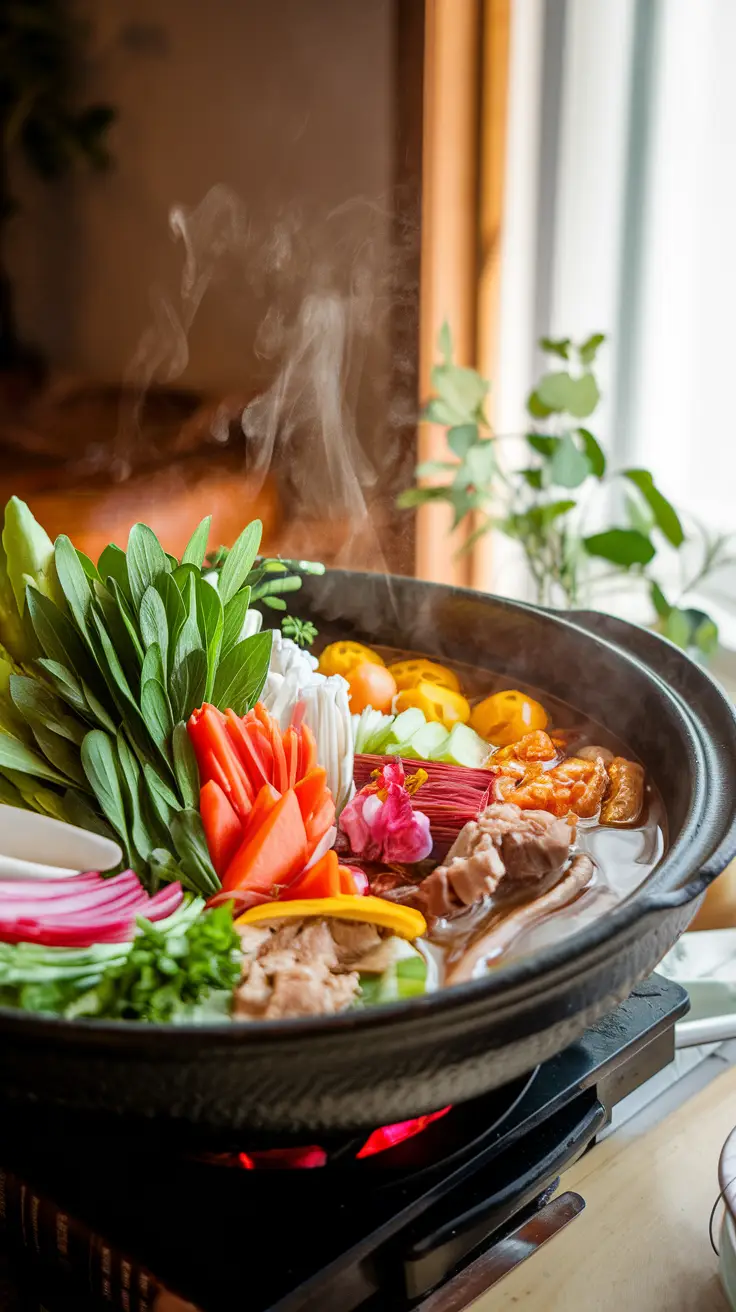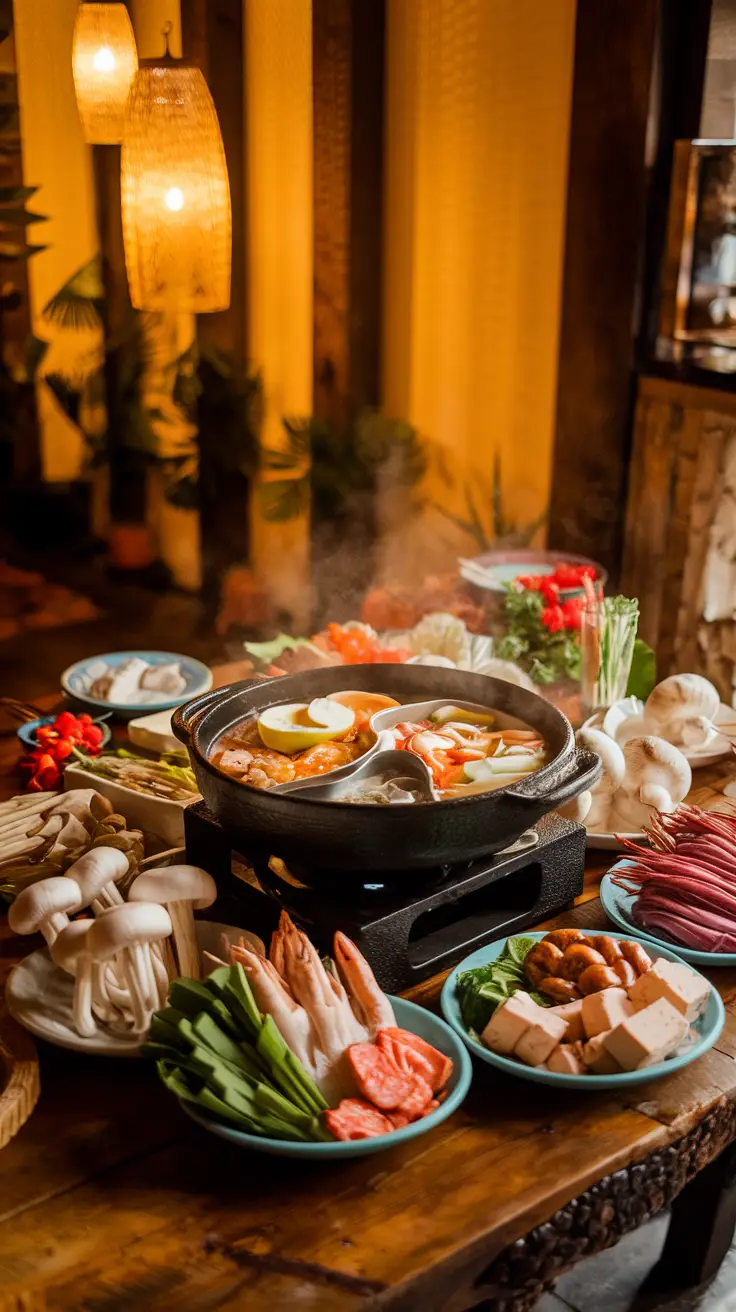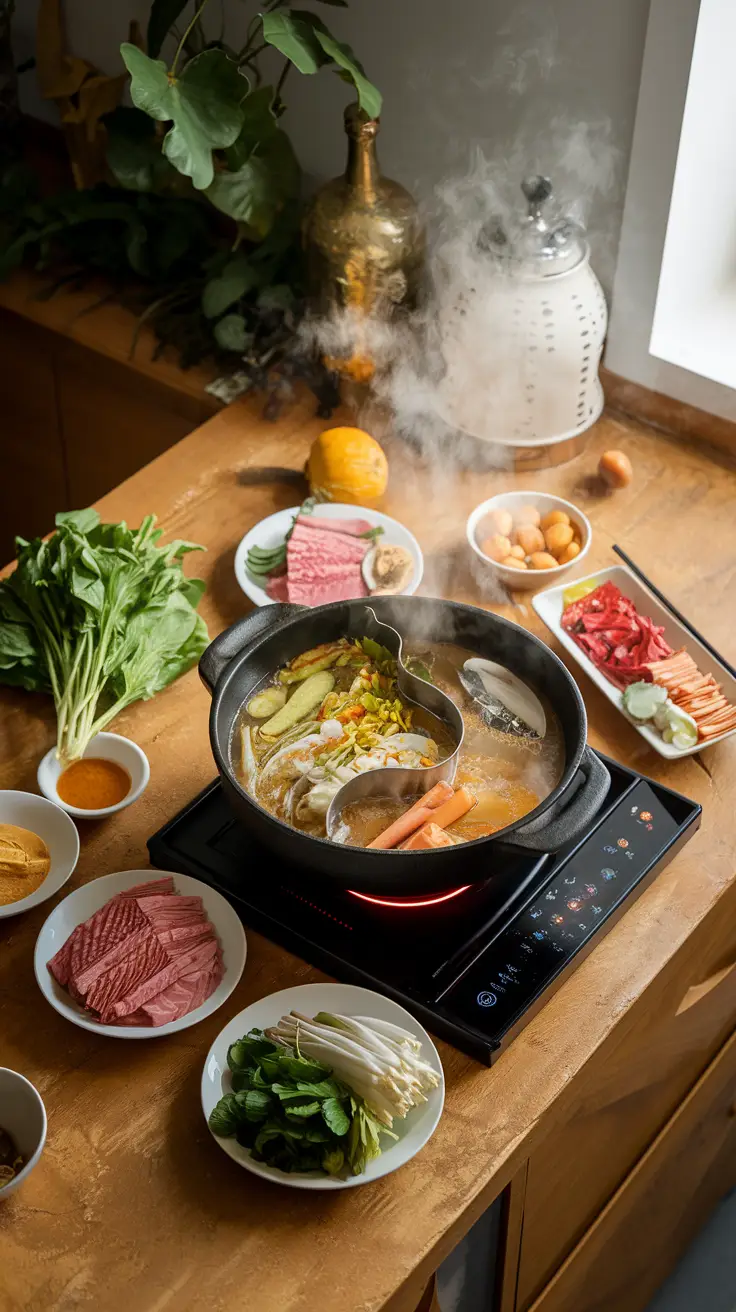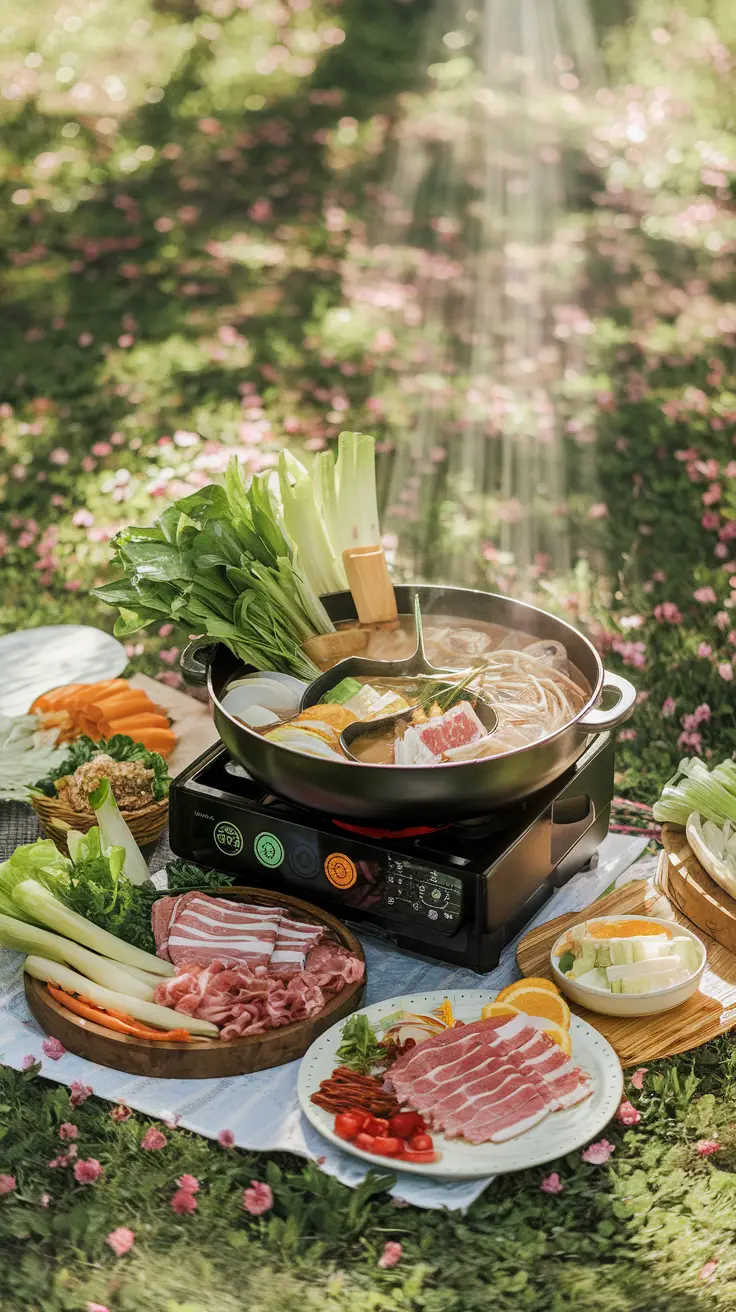Introduction to Vietnamese Hot Pot
Vietnamese Hot Pot, or Lẩu, is a beloved culinary tradition in Vietnam. This dish brings people together to share a meal filled with flavors. It typically features a simmering pot of broth at the center of the table. Diners add various fresh ingredients to the pot, creating a communal dining experience.
Common ingredients include vegetables, seafood, and thinly sliced meats. As the food cooks in the broth, it absorbs rich flavors from the ingredients. Furthermore, diners often enjoy dipping sauces to enhance the taste. Overall, Vietnamese Hot Pot represents not just a meal but also a cultural activity that emphasizes togetherness.

Nutritional Value and Health Benefits
Vietnamese Hot Pot is not only a delicious dish but also packed with nutrients. It typically includes fresh vegetables, seafood, and meats, making it a balanced meal. Each ingredient contributes essential vitamins and minerals. For example, leafy greens are rich in vitamins A and C, while seafood provides omega-3 fatty acids.
The broth is usually made from natural ingredients, which can offer health benefits. Ingredients like ginger and lemongrass may aid digestion and provide anti-inflammatory properties. Moreover, the cooking method is health-conscious, as it involves boiling rather than frying.
This hot pot encourages social gatherings, which can promote mental well-being. Sharing food can enhance relationships, making meals more enjoyable. Overall, the blend of flavors and nutritional content makes Vietnamese Hot Pot a favorable choice.
| Ingredient | Health Benefit |
|---|---|
| Seafood | Rich in omega-3 fatty acids |
| Vegetables | High in vitamins and minerals |
| Broth | Contains herbs with digestive benefits |

Taste Profile and Texture of Vietnamese Hot Pot
Vietnamese Hot Pot offers a rich and diverse taste experience. The broth, often simmered with savory ingredients, serves as the foundation. It can be clear or spicy, depending on regional variations. You’ll find a blend of herbs and spices that intensify the overall flavor. Dishes like this often feature lemongrass, galangal, and fish sauce. Furthermore, these components create a deliciously fragrant broth.
Texture Experience
When enjoying Vietnamese Hot Pot, the textures play a crucial role. Various ingredients, such as meats, seafood, and vegetables, introduce delightful contrasts. You’ll experience tender slices of beef or chicken alongside firm tofu. Additionally, the fresh greens add a crisp bite. As you dip ingredients into the broth, the heat brings out unique textures.
- Tender meats: These melt in your mouth.
- Crisp vegetables: They provide a refreshing crunch.
- Silky noodles: These add a comforting element.
Transitioning between flavors and textures keeps the dining experience exciting. Each bite offers something different, captivating your palate. Moreover, the communal aspect of cooking at the table enhances interactions and enjoyment. Friends and family gather around the pot, sharing in the preparation and tasting.
In summary, the taste profile and texture of Vietnamese Hot Pot create a satisfying and memorable meal. With layered flavors and a variety of ingredients, it’s no wonder this dish is beloved. If you haven’t tried it yet, consider bringing friends along for a delightful experience.

Culinary Uses and Popular Dishes: Vietnamese Hot Pot
Vietnamese Hot Pot is a cherished dish that embodies communal dining. It usually consists of a simmering pot of broth served at the table. Diners add various ingredients like thinly sliced meats, seafood, and vegetables. The interactive nature enhances the dining experience, allowing everyone to customize their meal.
Common Ingredients in Vietnamese Hot Pot
- Broth: Often made with fresh herbs, spices, and vegetables.
- Meats: Thin cuts of beef, pork, or chicken.
- Seafood: Shrimp, fish, or squid are popular choices.
- Vegetables: Leafy greens, mushrooms, and bean sprouts are commonly added.
- Noodles: Rice noodles soak up the flavorful broth.
This dish is versatile and can vary by region. Some, like the spicy tom yum hot pot, utilize a bold broth. Others focus on a lighter, herbal flavor. Vietnamese Hot Pot unites people, making every meal an occasion.

Sourcing and Sustainability
Sourcing ingredients for Vietnamese Hot Pot involves careful consideration of sustainability. Local markets are ideal for finding fresh produce and seafood. This not only supports the local economy but also ensures that ingredients are seasonal and flavorful. Additionally, many chefs emphasize using organic and responsibly harvested items. They understand the importance of minimizing environmental impact.
For proteins, consider sourcing from farms that follow ethical practices. This supports animal welfare and leads to better quality meals. Moreover, by prioritizing sustainable options, it encourages the preservation of natural resources.
How to Select and Store
Choosing the right ingredients for Vietnamese hot pot is essential for a delicious experience. Look for fresh, high-quality items when selecting your ingredients. Consider the following tips:
- Freshness: Choose ingredients that are fresh and free from blemishes.
- Variety: Opt for a mix of proteins, vegetables, and noodles for a well-rounded meal.
- Seasonality: Select seasonal vegetables for the best flavor and texture.
- Storage: Keep ingredients refrigerated and consume them within a few days for optimal freshness.
- Packaging: For packaged items, check expiration dates and seals before purchasing.
Storing your ingredients properly will enhance their flavors. Ensure to store proteins at a suitable temperature. Meanwhile, keep vegetables in breathable bags to maintain their crispness.
Preparation Tips and Techniques for Vietnamese Hot Pot
Preparing a delicious Vietnamese Hot Pot requires attention to detail and the right ingredients. First, select fresh vegetables, herbs, and proteins. Fresh ingredients enhance the flavor and texture of your dish. It’s essential to prep everything in advance, so your dining experience flows smoothly.
Key Tips for Preparation
- Choose the Right Broth: A good broth is the foundation of any hot pot. You can make a spicy or a mild broth based on your preferences.
- Fresh Ingredients: Always opt for the freshest vegetables and proteins. Consider options like fish, shrimp, beef, and assorted mushrooms.
- Cut Ingredients Uniformly: Evenly cutting the ingredients ensures they cook at the same rate during the hot pot session.
- Marinate Proteins: Marinating your proteins briefly before cooking can elevate the overall flavor.
Lastly, remember to enjoy the process. Gather friends and family, as sharing a Vietnamese Hot Pot is about community and togetherness.
Recipe Inspiration
Vietnamese Hot Pot is a delightful dish that brings friends and family together. This communal meal is not just about eating; it’s also about sharing the experience. To prepare a delicious Vietnamese Hot Pot, gather fresh ingredients. You can use a variety of meats, seafood, and vegetables. Common choices include fish, shrimp, mushrooms, and leafy greens. Consider adding rice noodles for a filling option.
Choose a flavorful broth to enhance the taste. A combination of herbs and spices such as lemongrass, ginger, and chili can elevate the flavors significantly. Once the broth is simmering, cook your selected ingredients right at the table. This engages everyone and makes the meal interactive.
Finally, don’t forget the dipping sauces. They can range from a simple soy sauce to complex mixes featuring lime and chili. These enhance each bite, making your Vietnamese Hot Pot truly unforgettable.
Fun Facts and Trivia
Vietnamese Hot Pot, also known as Lẩu, is more than just a meal. It represents a social experience for families and friends.
- Unlike traditional hot pots, which often include meat and vegetables, Vietnamese versions often feature seafood.
- Each region in Vietnam has its unique style of hot pot, reflecting local ingredients.
- Popular choices of broth include spicy, sour, and herbal blends.
- Eating hot pot is often a communal affair, perfect for gatherings.
- It’s common to dip fresh ingredients into the boiling broth and enjoy with various dipping sauces.
These elements make it a delightful and interactive dining experience.
Conclusion and Dining Experience of Vietnamese Hot Pot
Dining on Vietnamese Hot Pot offers a unique, interactive experience. Guests enjoy cooking fresh ingredients at the table. This communal style promotes sharing and conversation. Fresh vegetables, meats, and aromatic broths create delightful flavor combinations. The process is as enjoyable as the meal itself.
Moreover, it can cater to various tastes. You can choose spicy or mild broths, making it versatile. Additionally, restaurants often provide an extensive selection of dipping sauces. This allows guests to customize their dining experience further.
In summary, hot pot is more than a meal; it is a fun, memorable experience for all. Whether hosting a gathering or enjoying a night out, it delivers warmth and connection.
